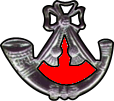Light Infantry - Rand
SOUTH AFRICAN DEFENCE FORCES
The Rand Light Infantry

Motto
"Vincit qui patitur".
(He conquers who endures.)
Battle Honours
South West Africa 1914-15
Western Desert 1941-43
Bardia
Gazala
Alamein Defence
El Alamein
History
The Rand Light Infantry originated shortly after
the South African War when, on October 1, 1905,
the Transvaal Cycle Corps was formed as a volunteer
regiment after the British troops had sailed home.
Being volunteers the men had supplied their own
bicycles and almost immediately experienced their
baptism of fire when 24 men and an officer, part
of No.3 Section of the Transvaal Light Infantry,
were sent to put down the Bambata Rebellion in
Zululand.
On its return the Cycle Corps recognised the
possibilities of mechanisation and the rear seats
of a de Dion Bouton were replaced by a platform
and heavy machine guns. This inspired the addition
of two more armoured cars creating a motorised
fighting unit and in 1909 led to a change in name
to the Transvaal Cycle and Motor Corps.
After Union in 1910 and the end of the volunteer
movement, the Rand Light Infantry got its present
title and was organised under the Defence Act
as an Active Citizen Force Unit. It was first
mobilised during the industrial unrest of 1914
to guard the Newlands subway and the Braamfontein
station using motorcycle mounted despatch riders.
At the outbreak of World War 1 all A.C.F. units
were called up and the RLI was stationed at the
Booysens Shooting Range before leaving for Cape
Town and the Wouth West Africa Campaign on September
7 1914. First action in this campaign was at Luderitz
Bay on September 26 1914 and the RLI spent nine
months chasing German forces, suffering light
casualties - two dead and eleven wounded.
The first King’s Colour was presented to
the Regiment in 1921 and a year later the unit
was involved in the fighting during the mineworkers
strike. It’s main task was patrol duties
on the Witwatersrand and casualties were two dead
and three wounded. First Regimental Colour was
presented to the RLI in 1932.
It was North Africa during World War II that
the RLI really carved a name in military annals
taking part in front line engagements and earning
battle honours at Bardia, Gazala and El Alamein.
Called up in June 1940, the regiment embarked
for Egypt a year later where it was joined by
150 RLI transport personnel from the 1st South
African Division in East Africa. Unit strength
was 900 but unhappily 300 of these men were never
to return home.
After the surrender of Rommel’s Afrika
Korps the Regiment returned home to be merged
with the Duke of Edinburgh’s Own Rifles.
They were trained in armour, sending reinforcements
to the South African Sixth division in Italy.
As an amalgamation of the Duke’s, Scottish
and RLI it went to Italy as an infantry unit.
In 1947, during the Royal Visit to south Africa,
a new King’s Colour was presented to the
unit and it received the Freedom of the City of
Johannesburg on its 50th Anniversary, October
1, 1955.
Background to the Alliance
The RLI were allied to the Duke of Cornwall’s
Light Infantry in 1932. This alliance fell into
abeyance during the period of secession and was
resurrected in April 1995 with The Light Infantry.
|

